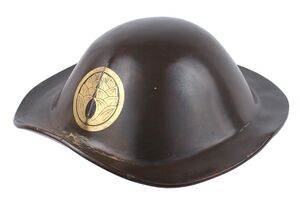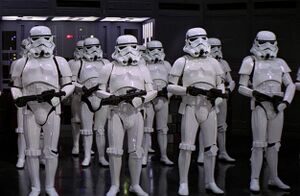Helmet

A Helmet is a variety of hat which is designed to protect the wearer's head not just from cold and wetness, but also from external damage from blows.
Reasons for wearing a Helmet
- Sport Safety (Hockey, American Football, Lacrosse)
- Vehicular safety (motorcylcing, bicycling)
- Workplace Safety
- Extra Vehicular Activity
- Hazmat Work
- Entering a Combat Situation
Materials to make a helmet out of
- Wood, if you have trees but metal is scarce or you are really primitive
- Wool, if you have sheep but metal is scarce or you are really primitive, this applies to other textiles as well
- Leather, if you have large animals but metal is scarce, you are really primitive or are at the bottom of the social ladder
- Bronze, if you are living in the bronze age
- Steel, if your society has mastered iron working and does not want to put up with importing tin and/or copper
- Plastics
- Ceramics and ballistic textiles, if you are in the modern age and want to stop shrapnel and pistol rounds out of your brain
- Tinfoil, to keep out the FBI/CIA/NSA/MI6/CSIS/Russian/European Union/Chinese/Indian/Templar/Google/Scientologist/Vatican/Wold Bank/NWO/MIB/Moon Nazi/Mars Soviet/Mercury Empire of Japan/Asteroid Belt Napoleonic Empire/Lizard Men/Pinniped mind control rays.
Some types of helmets
- Boar Tusk Helmet: From Mycenaean Greece (1600 BCE to 1200 BCE), it was made by making a leather hat and sewing onto it slices of boar tusks. Making such a helmet required hunting down and killing something like 40 boars for their tusks, which was pretty badass.
- Corinthian: Most popular variety of ancient (800 BCE to 0) Greek Hoplite Helmet, made of bronze, a single piece affair with built in cheek guards and nose guard (known as a nasal). Often had a horse hair/plumed crest.
- Galea: The Helmet worn by Roman legionaries, made out of several pieces of bronze or steel. Had cheek guards on hinges and a back guard to protect the neck. Came with a detachable horse hair/plumed chrest for special occasions. Unlike most helmets of it's time it does not cover ears, because being able to hear orders is actually more important, especially in Roman maniple formation, where coordination was EVERYTHING. Being practical SOB's, Romans even added special hook to fix the helmet on the soldiers belt when on the march, because marching all day long with heavy chunk of metal on your head is usually a bad idea, unless your neck is as thick as normal man's hip, and keeping your helmet on the supply cart is an even worse idea, unless you don't expect ambushes (and good soldiers on the march should always expect ambushes).
- Spangenhelm: A dark age (5th to 9th century) helmet made of bits of iron forged riveted onto a frame. An easier form to forge than an iron bowl for unskilled smiths. Sometimes had a nasal or cheek guards attached.
- Cervelliere: A dark age/medieval helmet composed of a single steel dome. Became more common as armorers got better at their trade. It might come with a nasal.
- Kettle Hat: A steel dome with a wide brim around it, sometimes with a nasal. A common helmet for common soldiers in the late middle ages as it offered a good deal of protection against arrows while allowing good visability, though it covered less of the head.
- Maille Coif: To better protect people's heads, they often wore hoods made of chainmail. Often, though not always in conjunction with a more conventional helmet. This practice was common across Europe, the Middle East and Asia.
- Greathelm: A steel bucket with eyeholes wore by knights.

- Barbute Corinthian 2, Electric Boogaloo! Basically a Corthinian Helmet made of steel minus the chrest.
- Sallet: A type of steel helmet from the late middle ages. It's main component covered cheeks and had a lock neckguard in the back. To protect the face it would have a face guard bolted on, which could be raised or lowered.
- Morion: A type of helmet similar to a Kettle hat, but with a top part which came to a ridge and dipped down on the sides to cover the ears. Often morions would have cheek guards. Most commonly associated with Conquistadors.
- Lobster Pot: A helmet from the Renaissance period and age of enlightenment composed of a steel dome with a visor, cheek guards and a back guard made of overlapping steel plates rivet together (looking like a lobster tail). They usually came with a nasal or a faceguard of some sort. These helmets were used by both cavalry and infantry.
- Kanabo: Japanese Samurai helmets, have a dome part as well as a back made of laminar protecting the neck and cheeks. For facial protection they had a mempo, a stylized mask.
- Jingasa: Japanese Ashigaru Helmet, these were usually cone shaped (though latter ones bore a resemblance to Morions and kettle hats) and made of steel or lacquered wood.
- Adrian Helmet: Helmets fell out of fashion starting around the 18th century as they were often not much use against firearms and were deemed to be dead weight and unnecessary expense by the armies of Europe. This changed during the Great War, artillery shells would splinter into fragments when they exploded, these fragments could be stopped by a simple steel helmet. The French found this out first and in 1915 first made the Adrian Helmet out of stamped steel and reduced shrapnel casualties significantly. It had a brim which was more prominant in the front.
- Brodie Helmet: The British thought the French were onto a good idea with their Adrian helmets and designed their own. The Brodie Helmets were based off Kettle Hats. Used by troops across the British Empire during both world wars and by US troops during the Great War.
- Stahlhelm:The Germans also thought the French were onto a good idea with their Adrian helmets and designed their own. The Stahlhelm was based off the Sallet. It is considered to be the best helmet of that time period as it protected the neck and ears. In fact, it was so good that even the Chinese were buying them like a drug-filled hooker (Which gave an unfortunate confusion on who is the Chinese and Germans during WW2). It would later became commonly associated with the nazis.
- M1 Helmet: The US decided that the Brodie Helmet did not quite cut the mustard, so they designed their own helmet for use during WWII. It was thicker and bent down in the back.
- Modern Combat Helmet: Modern Combat Helmets like the British Mk-7 or the Advanced Combat Helmet are made of layers of metal, fiberglass, ceramics and ballistic textiles, often with a cloth covering for camouflage purposes.
Helmets and Faces

Helmets are the most common type of combat armor employed in History. Helmets protect your brain, your most important organ, from damage. Some also protect some combination of the eyes, ears, nose, and mouth, all of which are nearly as vital. When compared to a breastplate or other such article of torso armor, helmets are fairly easy and inexpensive to make, while being easy and unobtrusive to wear. If you had to have just one bit of armor, you got a helmet. Helmets came in many shapes and sizes. Even a re-purposed cooking pot will do in a pinch. Covering as much of the head as possible often improved a helmet's performance in a purely functional-as-armor sense. However, if your entire head is sheathed in vision-obstructing, hearing-distorting, badly-ventilated metal with a few small holes to look and breathe out of, you clearly have some disadvantages over a fellow wearing one of its skimpier but less-obstructive counterparts.
However, for visual fiction, full-face helmets can be problematic as they hide the faces of the character and as such, limit what emotions and features can be shown to the audience, as well as concealing his his/her identity and making them less relatable, ironically serving the opposite function of all other varieties of hats. For this reason, full head helmets are usually reserved for faceless enemies employed by the enemy to be killed with a minimum of audience empathy while heroes wear helmets which leave their faces exposed, or simply go helmetless into combat situations. The most common exception to this rule is to conceal the fact that the wearer is female, as so she can prove her martial skills to the surrounding characters who hold to pre-modern prejudices about gender and shock them with a surprise revelation of her gender when it is removed.